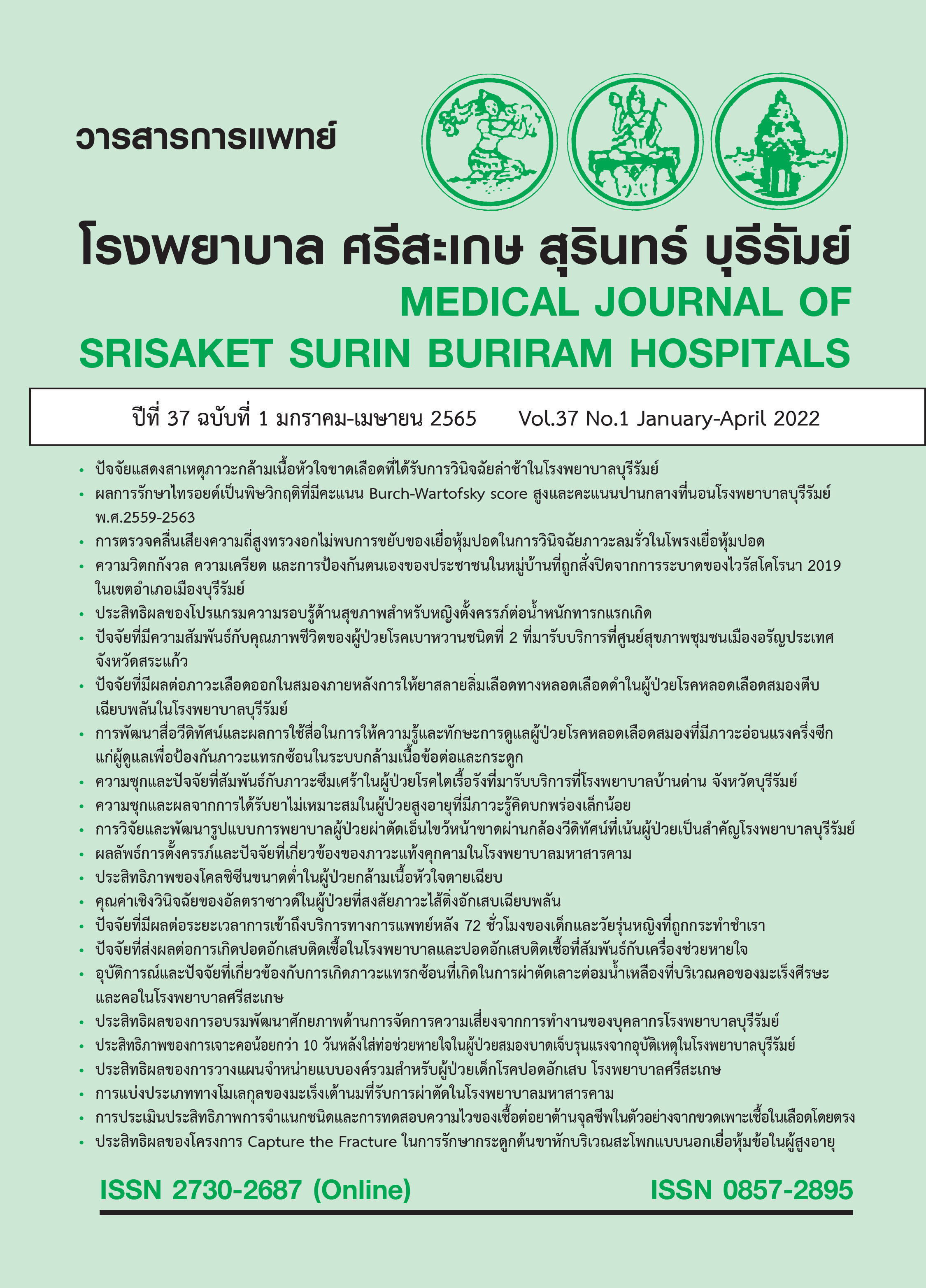ปัจจัยที่มีผลต่อภาวะเลือดออกในสมองภายหลังการให้ยาสลายลิ่มเลือดทางหลอดเลือดดำในผู้ป่วยโรคหลอดเลือดสมองตีบเฉียบพลันในโรงพยาบาลบุรีรัมย์
Main Article Content
บทคัดย่อ
บทนำ: โรคหลอดเลือดสมอง เป็นโรคทางระบบประสาทที่พบบ่อยเป็นสาเหตุการเสียชีวิตสูงเป็นอันดับ 2 ของ ประชากรที่อายุมากกว่า 60 ปี และนำพาไปสู่ภาวะทุพพลภาพ การให้ยาสลายลิ่มเลือดทางหลอดเลือดดำใน ผู้ป่วยโรคหลอดเลือดสมองตีบที่มาใน 3-4.5 ชั่วโมง ช่วยลดอัตราตายและความพิการ อย่างไรก็ตามการให้ยา สลายลิ่มเลือดมีภาวะแทรกซ้อนที่สำคัญคือเลือดออกในสมองซึ่งนำไปสู่การเสียชีวิตทั้งนี้การศึกษาในประเทศไทยยังมีไม่มากนัก ข้อมูลยังมีความแตกต่างกันในแต่ละการศึกษา
วัตถุประสงค์: เพื่อศึกษาปัจจัยที่มีผลต่อภาวะเลือดออกในสมองภายหลังการให้ยาสลายลิ่มเลือดทางหลอดเลือดดำในผู้ป่วย โรคหลอดเลือดสมองตีบเฉียบพลัน
รูปแบบศึกษา: การศึกษา Prognostic factor research รูปแบบ retrospective observational cohort design ที่กลุ่ม งานอายุรกรรม โรงพยาบาลบุรีรัมย์ โดยทำการศึกษาในผู้ป่วยโรคหลอดเลือดสมองตีบที่ได้รับยาสลายลิ่มเลือด ระหว่าง เดือน มกราคม พ.ศ.2559 ถึง เดือน ตุลาคม พ.ศ. 2563
วิธีการศึกษา: ค้นหาข้อมูลผู้ป่วยเส้นเลือดสมองตีบที่ได้รับการรักษาด้วยยาสลายลิ่มเลือด บันทึกข้อมูลพื้นฐาน ผลการตรวจทางห้องปฏิบัติการ ผลเอกเรย์คอมพิวเตอร์สมอง เปรียบเทียบ 2 กลุ่มได้แก่ กลุ่มที่ไม่มีเลือดออกในสมองและกลุ่มที่มีเลือดออกในสมอง วิเคราะห์ปัจจัยเสี่ยงที่มีผลต่อการเกิดเลือดออกในสมองด้วยสถิติ multivariable logistic regression
ผลการศึกษา: จำนวนผู้ป่วย 655 ราย พบภาวะเลือดออกในสมองร้อยละ 15.4 (asymptomatic ICH ร้อยละ7.3, symptomatic ICH ร้อยละ8.1) อายุเฉลี่ย 64 ปี เพศชายร้อยละ 51.6 คะแนน NIHSS เฉลี่ย 11 ปัจจัยเสี่ยงต่อการเกิดเลือดออกในสมองได้แก่ สาเหตุของโรคหลอดเลือดสมองชนิด Largeartery atherosclerosis เสี่ยง 6.80 เท่า (95%CI 1.57-29.45, p=0.010), Cardio embolism เสี่ยง 12.40 เท่า (95%CI 2.83-54.40, p=0.001), Other etiologies เสี่ยง 18.86 เท่า (95%CI 2.24-159.03, p=0.007) และ CT brain พบ early infarction เสี่ยง 2.98 เท่า (95%CI 1.75-5.09, p<0.001) ส่วนอายุ โรคไขมันโลหิตสูง Systolic blood pressure คะแนน NIHSS ระดับเกล็ดเลือด ยังไม่พบว่ามีนัยสำคัญทางสถิติ
สรุป: ในผู้ป่วยโรคหลอดเลือดสมองตีบที่เกิดจาก Large artery atherosclerosis, Cardioembolism, Other etiologies และ ผู้ป่วยที่ CT brain พบ early infarction ควร counseling ให้ผู้ป่วยทราบถึงความเสี่ยงของ การเกิดเลือดออกในสมอง และยอมรับความเสี่ยงที่เกิดขึ้นในกรณีที่มีการให้ยาสลายลิ่มเลือด และต้องเฝ้าระวังเป็นพิเศษในผู้ป่วยกลุ่มนี้ที่ได้รับยาสลายลิ่มเลือด
Article Details

อนุญาตภายใต้เงื่อนไข Creative Commons Attribution-NonCommercial-NoDerivatives 4.0 International License.
เอกสารอ้างอิง
GBD 2019 Stroke Collaborators Global, regional, and national burden of stroke and its risk factors, 1990-2019: a systematic analysis for the Global Burden of Disease Study 2019. Lancet Neurol 2021;20(10):795-820. doi: 10.1016/S1474-4422(21)00252-0. Epub 2021 Sep 3.
National Institute of Neurological Disorders and Stroke rt-PA Stroke Study Group. Tissue plasminogen activator for acute ischemic stroke. N Engl J Med 1995;333(24):1581-7. doi: 10.1056/NEJM199512143332401.
Larrue V, von Kummer R R, Müller A, Bluhmki E. Risk factors for severe hemorrhagic transformation in ischemic stroke patients treated with recombinant tissue plasminogen activator: a secondary analysis of the European-Australasian Acute Stroke Study (ECASS II). Stroke 2001;32(2):438-41. doi: 10.1161/01.str.32.2.438.
Suwanwela NC, Phanthumchinda K, Likitjaroen Y. Thrombolytic therapy in acute ischemic stroke in Asia: The first prospective evaluation. Clin Neurol Neurosurg 2006;108(6):549-52. doi: 10.1016/j.clineuro.2005.09.008.
Hacke W, Kaste M, Bluhmki E, Brozman M, Dávalos A, Guidetti D, et al.Thrombolysis with alteplase 3 to 4.5 hours after acute ischemic stroke. N Engl J Med 2008;359(13):1317-29. doi: 10.1056/NEJMoa0804656.
Wahlgren N, Ahmed N, Eriksson N, Aichner F, Bluhmki E, Dávalos A, et al. Multivariable analysis of outcome predictors and adjustment of main outcome results to baseline data profile in randomized controlled trials: Safe Implementation of Thrombolysis in Stroke-MOnitoring STudy (SITS-MOST). Stroke 2008;39(12):3316-22. doi: 10.1161/STROKEAHA.107.510768.
Muengtaweepongsa S, Prapa-Anantachai P, Dharmasaroja PA, Rukkul P, Yodvisitsak P. External validation of the SEDAN score: The real world practice of a single center. Ann Indian Acad Neurol 2015 ;18(2):181-6. doi: 10.4103/0972-2327.150592.
Phuttharak W, Sawanyawisuth K, Sangpetngam B, Tiamkao S, Kongbunkiat K, Chotmongkol V, et al. Risk factors for intracerebral hemorrhage after treatment with recombinant tissue-type plasminogen activator for acute ischemic stroke. Asian Biomed 2015;9(3):397-400. doi: https://doi.org/10.5372/1905-7415.0903.409
Lokeskrawee T, Muengtaweepongsa S, Patumanond J, Tiamkao S, Thamangraksat T, Phankhian P, et al. Prognostic Parameters for Symptomatic Intracranial Hemorrhage after Intravenous Thrombolysis in Acute Ischemic Stroke in an Asian Population. Curr Neurovasc Res 2017;14(2):169-176. doi: 10.2174/1567202614666170327163905.
Siriyutwattana C, Srisuwannanukorn S, Winitprichagul S. Incidence and Associated Factors of Intracranial Hemorrhage after Intravenous Thrombolysis for Acute Ischemic Stroke in Vajira Hospital. วารสารประสาทวิทยาแห่งประเทศไทย 2563;36(2):51-6.
Whiteley WN, Slot KB, Fernandes P, Sandercock P, Wardlaw J. Risk factors for intracranial hemorrhage in acute ischemic stroke patients treated with recombinant tissue plasminogen activator: a systematic review and meta-analysis of 55 studies. Stroke 2012;43(11):2904-9. doi: 10.1161/STROKEAHA.112.665331
สุจริต สวนกูล, ธานินทร์ โลเกศกระวี. ปัจจัยที่มีผลต่อภาวะเลือดออกในสมอง ภายหลังการให้ยาละลายลิ่มเลือดทางหลอดเลือดดำ ในผู้ป่วยโรคหลอดเลือดสมองตีบ หรืออุดตันเฉียบพลัน. ลำปางเวชสาร 2559;37(2):67-77.
Dharmasaroja PA, Muengtaweepongsa S, Pattaraarchachai J, Dharmasaroja P. Intracerebral hemorrhage following intravenous thrombolysis in Thai patients with acute ischemic stroke. J Clin Neurosci 2012 ;19(6):799-803. doi: 10.1016/j.jocn.2011.08.035.
Lin X, Cao Y, Yan J, Zhang Z, Ye Z, Huang X, et al. Risk Factors for Early Intracerebral Hemorrhage after Intravenous Thrombolysis with Alteplase. J Atheroscler Thromb 2020;27(11):1176-1182. doi: 10.5551/jat.49783.
Liu M, Pan Y, Zhou L, Wang Y. Predictors of post-thrombolysis symptomatic intracranial hemorrhage in Chinese patients with acute ischemic stroke. PLoS One 2017;12(9):e0184646. doi: 10.1371/journal.pone.0184646.
Whiteley WN, Emberson J, Lees KR, Blackwell L, Albers G, Bluhmki E, et al. Risk of intracerebral haemorrhage with alteplase after acute ischaemic stroke: a secondary analysis of an individual patient data meta-analysis. Lancet Neurol 2016;15(9):925-33. doi: 10.1016/S1474-4422(16)30076-X
Mazya M, Egido JA, Ford GA, Lees KR, Mikulik R, Toni D, Predicting the risk of symptomatic intracerebral hemorrhage in ischemic stroke treated with intravenous alteplase: safe Implementation of Treatments in Stroke (SITS) symptomatic intracerebral hemorrhage risk score. Stroke 2012;43(6):1524-31. doi: 10.1161/STROKEAHA.111.644815.
วสันต์ ลิ่มสุริยกานต์, พิมพ์กานต์ หล่อวณิชย์. ปัจจัยที่เกี่ยวข้องกับภาวะเลือดออกในสมองในผู้ป่วยโรคสมองขาดเลือดที่ได้รับ rtPA ในโรงพยาบาลพระนครศรีอยุธยา. วารสารโรงพยาบาลธรรมศาสตร์เฉลิมพระเกียรติ 2564;6(1):12-20.
Lansberg MG, Thijs VN, Bammer R, Kemp S, Wijman CA, Marks MP, et al. Risk factors of symptomatic intracerebral hemorrhage after tPA therapy for acute stroke. Stroke 2007;38(8):2275-8. doi: 10.1161/STROKEAHA.106.480475.


